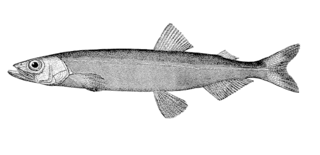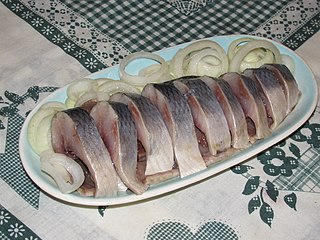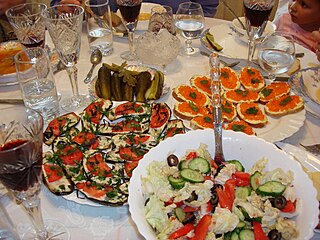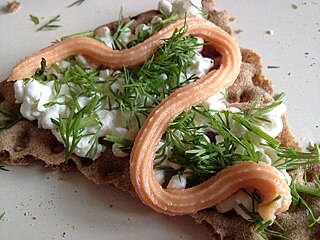In food processing, brining is treating food with brine or coarse salt which preserves and seasons the food while enhancing tenderness and flavor with additions such as herbs, spices, sugar, caramel or vinegar. Meat and fish are typically brined for less than twenty-four hours while vegetables, cheeses and fruit are brined in a much longer process known as pickling. Brining is similar to marination, except that a marinade usually includes a significant amount of acid, such as vinegar or citrus juice. Brining is also similar to curing, which usually involves significantly drying the food, and is done over a much longer time period.

Roe, or hard roe, is the fully ripe internal egg masses in the ovaries, or the released external egg masses, of fish and certain marine animals such as shrimp, scallop, sea urchins and squid. As a seafood, roe is used both as a cooked ingredient in many dishes, and as a raw ingredient for delicacies such as caviar.

The capelin or caplin is a small forage fish of the smelt family found in the North Atlantic, North Pacific and Arctic oceans. In summer, it grazes on dense swarms of plankton at the edge of the ice shelf. Larger capelin also eat a great deal of krill and other crustaceans. Among others, whales, seals, Atlantic cod, Atlantic mackerel, squid and seabirds prey on capelin, in particular during the spawning season while the capelin migrate south. Capelin spawn on sand and gravel bottoms or sandy beaches at the age of two to six years. When spawning on beaches, capelin have an extremely high post-spawning mortality rate which, for males, is close to 100%. Males reach 20 cm (8 in) in length, while females are up to 25.2 cm (10 in) long. They are olive-coloured dorsally, shading to silver on sides. Males have a translucent ridge on both sides of their bodies. The ventral aspects of the males iridesce reddish at the time of spawn.

Russian cuisine is a collection of the different dishes and cooking traditions of the Russian people as well as a list of culinary products popular in Russia, with most names being known since pre-Soviet times, coming from all kinds of social circles.

Caviar is a food consisting of salt-cured roe of the family Acipenseridae. Caviar is considered a delicacy and is eaten as a garnish or spread. Traditionally, the term caviar refers only to roe from wild sturgeon in the Caspian Sea and Black Sea. The term caviar can also describe the roe of other species of sturgeon or other fish such as paddlefish, salmon, steelhead, trout, lumpfish, whitefish, or carp.

Pickled herring is a traditional way of preserving herring as food by pickling or curing.

Schmaltz is rendered (clarified) chicken or goose fat. It is an integral part of traditional Ashkenazi Jewish cuisine, where it has been used for centuries in a wide array of dishes, such as chicken soup, latkes, matzah brei, chopped liver, matzah balls, fried chicken, and many others, as a cooking fat, spread, or flavor enhancer.

Ajvar is a condiment made principally from sweet bell peppers and eggplants. The relish became a popular side dish throughout Yugoslavia after World War II and remains popular in Southeast Europe.

Orkla ASA is a Norwegian conglomerate operating in Europe, Asia and the US. At present, Orkla operates in the branded consumer goods, aluminium solutions and financial investment sectors. Orkla ASA is listed on the Oslo Stock Exchange and its head office is in Oslo, Norway. As of 31 December 2021, Orkla had 21,423 employees. The Group's turnover in 2021 totalled NOK 50.4 billion.

Coregonus artedi, commonly known as the cisco, is a North American species of freshwater whitefish in the family Salmonidae. The number of species and definition of species limits in North American ciscoes is a matter of debate. Accordingly, Coregonus artedi may refer either in a narrow sense to one of the several types of cisco found e.g. in the Great Lakes, or in a broad sense to the complex of all ciscoes in continental North American lakes, Coregonus artedi sensu lato.

The fishing industry in Scotland comprises a significant proportion of the United Kingdom fishing industry. A recent inquiry by the Royal Society of Edinburgh found fishing to be of much greater social, economic and cultural importance to Scotland than it is relative to the rest of the UK. Scotland has just 8.4 per cent of the UK population but lands at its ports over 60 per cent of the total catch in the UK.
Brim hf. is a fishing and fish processing company in Iceland. Brim's headquarters are in Reykjavík where its office and groundfish production are located. The company also runs fish processing plants in two other towns in Iceland, Akranes and Vopnafjörður.

Zakuski is an assortment of cold hors d'oeuvres, entrées and snacks in food culture in Slavic-speaking countries. It is served as a course on its own or "intended to follow each shot of vodka or another alcoholic drink". The word literally means 'something to bite after'. It probably originated and was influenced through the fusion of Slavic, Viking-Nordic and Oriental cultures in early Rus' regions like the Novgorod Republic.
Norway Pelagic is a producer and exporter of pelagic fish, such as atlantic herring, atlantic mackerel and capelin, caught in the seas close to Norway. Total raw material processed is on annual basis about 50% of total landings of pelagic fish in Norway processed for human consumption. Norway Pelagic ASA is listed on the Oslo Stock Exchange and its head office is in Ålesund, Norway.

Smörgåskaviar is the Swedish word for a fish roe spread eaten in the Nordic countries. Despite its name, smörgåskaviar is not actual caviar, i.e. sturgeon roe. Instead, it is a paste made from cod roe and a variable mix of other ingredients, which can include potato flakes, tomato sauce, onion, salt and sometimes dill or chives. It is sold in tubes in smoked and non-smoked variants, as well as in variants with a prominent taste of dill.

Herring are forage fish in the wild, mostly belonging to the family Clupeidae. They are an important food for humans. Herring often move in large schools around fishing banks and near the coast. The most abundant and commercially important species belong to the genus Clupea, found particularly in shallow, temperate waters of the North Pacific and North Atlantic Oceans, including the Baltic Sea, as well as off the west coast of South America. Three species of Clupea are recognized; the main taxon, the Atlantic herring, accounts for over half the world's commercial capture of herrings.

Red caviar is a caviar made from the roe of salmonid fishes, which has an intense reddish hue. It is distinct from black caviar, which is made from the roe of sturgeon.















